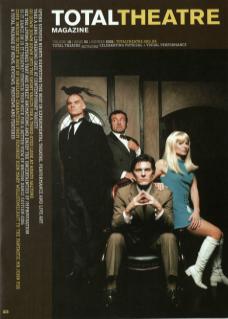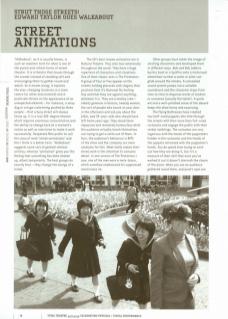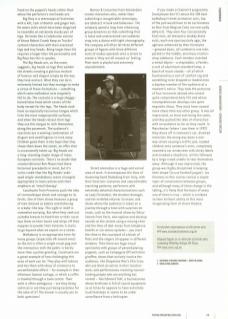'Walkabout', as it is usually known, is such an anaemic term for what is one of the purest and richest forms of street theatre. It is a theatre that moves through the crowds instead of standing still and encouraging them to gather round and watch. As it moves along, it exploits the ever-changing locations in a town centre (or other environment) and it positively thrives on the appearance of an unexpected element – for instance, a stray dog or a huge crate being pushed by three people – that a busy street will always throw up. It is a real 360-degree theatre which requires enormous concentration and the ability to change tack at a moment's notice as well as real nerve to make it work successfully. Desperate Men prefer to call this area of work 'street animations’ and this I think is a better term. 'Walkabout’ suggests some sort of genteel aimless activity, whereas 'animation' gives you the feeling that something has been shaken up, albeit temporarily. The best groups do exactly that – they change the energy of a street.
The UK's best-known animation act is Natural Theatre. They also tour extensively throughout the world. They have a huge repertoire of characters and situations. One of their classic acts is The Protestors. A group of four or five appear on the streets holding placards with slogans that proclaim that it's National No Smiling Day and that they are against anything, whatever it is. They are a motley crew – elderly generals in blazers, tweedy women, the sort of people who knock on your door in the afternoon and ask you about the bible, and 28 year-olds who should have left home years ago. They stand there impassive and resolutely humourless while the audience virtually knock themselves out trying to get a smile out of them. In fact, the audience's behaviour is 80% of the show and the company are mere catalysts for this. What really makes their shows work is the attention to costume detail. In one version of The Protestors I saw, one of the men wore a neck-brace, which somehow emphasised his suppressed reactionary ire.
Other groups have taken the image of strolling characters and developed them in different ways. Bob and Bob Jobbins build a boat or a Spitfire onto a motorised wheelchair so that a sailor or pilot can glide around the streets. A concealed sound system pumps out a suitable soundtrack and the character stops from time to time to dispense words of wisdom or nonsense (usually the latter). A quick wit and a well-polished sense of the absurd keeps the show funny and surprising.
The Flying Buttresses have created two half-sized puppets who hike through the streets with their more than full-sized rucksacks and engage the public with their verbal ramblings. The costumes are very ingenious, with the heads of the puppeteers hidden in the rucksacks and the heads of the puppets animated with the puppeteer's hands. You do spend time trying to work out how they are doing it, but it's a measure of their skill that once you've worked it out it doesn't diminish the charm of the piece. When you see an audience gathered round them, everyone's eyes are fixed on the puppet's heads rather than where the performer's real heads are.
Big Rory is a stereotypical Scotsman with a kilt, tam o'shanter and ginger hair. He wears stilts which have been disguised to resemble an extremely sturdy pair of legs. He looks like a Caledonian version of those Robert Crumb Keep on Truckin' cartoon characters with their oversized legs and tiny heads. Being larger than life requires a larger than life personality and Big Rory has this in spades.
The Big Heads are, as the name suggests, big heads on legs that wander the streets creating a glorious mixture of humour and disgust simply by the way they look and act. What they can do is extremely limited but they manage to make a virtue of these limitations – something which some walkabout acts singularly fail to do. The costume is a huge shaggy-haired latex head which covers all the body except for the legs. The heads each have an especially lascivious tongue which licks the most inappropriate surfaces, and when the heads retract their legs they use this tongue to inch themselves along the pavement. The audience's reactions are a winning combination of disgust and unwillingness to look away. Children goad them in the hope that they chase them down the street, an offer that is occasionally taken up. Big heads are a long-standing staple image of many European carnivals. There's no doubt that creator/director Bim Mason had these historical precedents in mind, but it's to his credit that the Big Heads' wide-eyed single-mindedness seems strangely appropriate in town centres with their emphasis on 'retail therapy'.
Cacahuete from Provence push the idea of carnivalesque shock and outrage to its limits. One of their shows features a group of men dressed as babies and behaving in a baby-like way. This sight in itself is somewhat worrying. But when they seek out suitable breasts to feed from or their nurse lays them on their backs and whips off their nappies to powder their bottoms it starts to go beyond what we expect on a street.
Walkabout is an appropriate term for many groups (especially UK-based ones) as the act is often a single visual gag and the interaction with the public is barely more than a polite greeting. Cacahuete are a great example of how challenging this area of work can be. They play with taboos and mix them with ideas of commerce to uncomfortable effect – for example in their infamous funeral cortege, in which a coffin is trawled through a town centre. Their work is often ambiguous – are they being satirical or are they just being tasteless for the sake of it? The answer is usually yes to both questions!
Warner & Consorten from Amsterdam create characters who, rather than subverting a recognisable stereotype, are abstract in look and behaviour. The company spend a long time rehearsing group dynamics so that something that is loose and unstructured can suddenly snap into a dance with tight choreography. The company will often let three different groups of figures with three different sorts of modus operandi onto a street to create a 'they are all around us' feeling. Their work is playful and extremely unpredictable.
Street animation is a huge and varied area of work. It encompasses the likes of drumming band Dadadang from Italy, with their futuristic costumes and unpredictable marching patterns, performers with extremely detailed characterisations such as Lady Christobel, the drunken dowager, and her wrinkled retainer Scrotum; and shows where the audience is taken on a journey through a town with surprises en route, such as the musical shows by Décor Sonore from Paris, who explore and develop sounds on the streets using a moving choir and the likes of dial-tones from telephone booths or car stereo systems – you start the show in the courtyard of a block of flats and the singers all appear in different windows. Then there are huge visual spectacles with groups of perambulating puppets, such as Compagnie Off with their giraffes, shows that actively involve the audience, like Desperate Men's Film Crew, who use them as extras in their location work; and performances involving normal-looking people who are anything but normal – like Edmond Tahl, a businessman whose briefcase is full of sound equipment so at times he appears to have extremely loud footsteps or seems to be under surveillance from a helicopter.
If you made a Channel 4 programme (and please don't!) about the 100 best walkabout/street animation acts, top of the poll would have to be Les Hommes en Noir from Belgium (who are now sadly defunct). They were four (occasionally five) men, all dressed in shabby black suits, each one spectacularly ugly, the ugliness enhanced by their hairstyles – greased down, all combed to one side, parted in the middle, enormous muttonchop sideburns. Each member clutched a metal object – a stepladder, a fender, a sort of aluminium standard lamp, a bunch of music stands – all of which functioned as a sort of comfort rag and something to be dropped or loaded onto a hapless member of the audience at a moment's notice. They took the personae of four innocents abroad who cannot quite comprehend daily life and whose incomprehension develops into quite exquisite chaos. They must have caused more chaos than any other group. It was all improvised, no show ever being the same, and they pushed the idea of interaction with an audience as far as they could. In Manchester (where I saw them in 1992) they drove off in someone's car, diverted motorists the wrong way down a one-way street causing a traffic jam, loaded children onto someone's arms, completely covered a car windscreen with sticky labels, and invaded a shopfront, all this followed by a large crowd unable to tear themselves away. Although it was improvised, the group was highly disciplined in keeping their shape (to use football jargon). Les Hommes en Noir stories remain a staple topic of conversation between groups, and although many of them change in the telling, it's likely that the basis of every one of them is true – which is a tribute to their brilliant ability at this most invigorating form of street theatre.
For further information on UK street arts see www.streetartsnetwork.org.uk
Edward Taylor is co-director of street arts company Whalley Range All Stars. See www.was.org.uk


